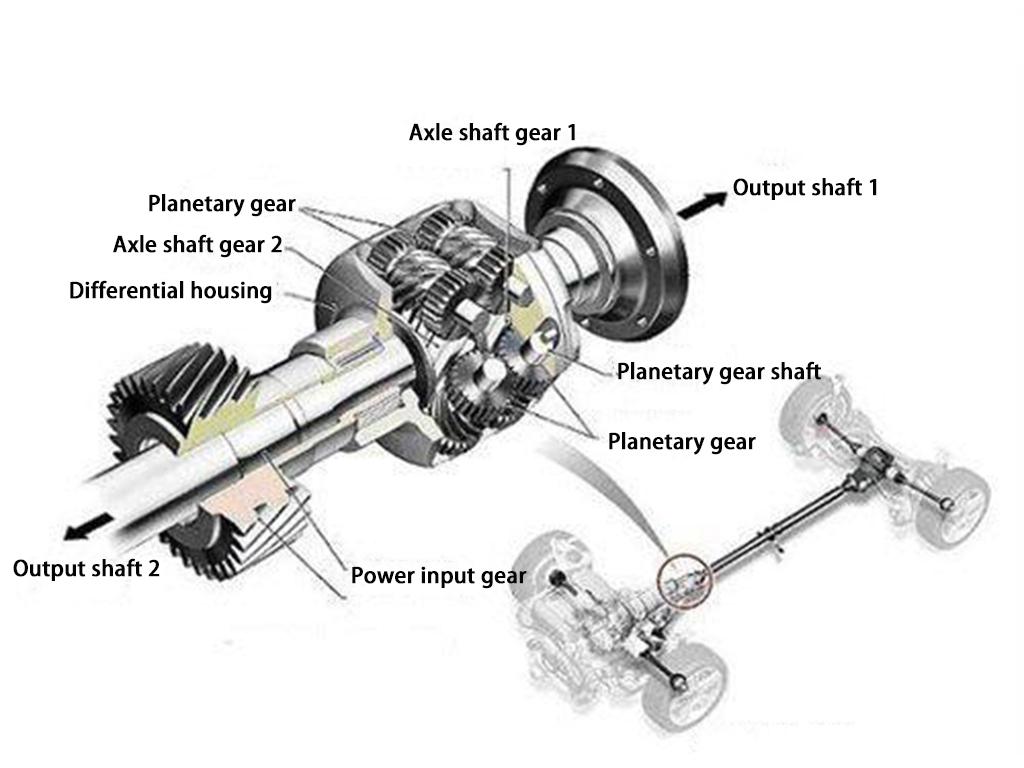[WapCar] In a multi-axis driving car, each drive axle is connected by a drive shaft. In order to make it possible for each drive axle to have different input angular velocities to eliminate the sliding phenomenon of the drive wheels of each axle, a central differential, also known as an inter-axle differential, can be installed between the drive axles.
The vehicle not only travels in a straight line, but also curves with various angles, when the vehicle travels in a curve, the trajectories of the four wheels are four arcs with different radii. This causes the four wheels to rotate at different speeds in the corners. If the wheels can only rotate at the same speed, the vehicle cannot turn at all, and even if the steering is forced, the middle axle will be broken due to the difference in wheel speed. At this time, it is necessary to install a differential to realize the differential speed, which can decompose a fixed speed on the engine output shaft into different speeds and transmit them to the wheels.
When the car turns, the turning radius of the front wheels is larger than that of the rear wheels on the same side, so the speed of the front wheels is faster than that of the rear wheels, so that the four wheels take completely different routes. Therefore, four-wheel drive vehicles need a central differential to distribute torque of front and rear axles.
The types of central differentials are: open central differential, multi-disc clutch differential, Torsen differential and viscous coupling differential.
Open central differential
An open differential is a differential that has no restrictions and can work normally when the car is turning, the planetary gear set does not have any locking device. If a four-wheel drive vehicle is equipped with three open differentials in the front, center and rear, if one of the wheels slips, then all the power of the car will be wasted on this wheel, while the other three wheels cannot reach the power.

Advantages: There is no special advantage, because the differential speed is a necessary condition for the normal driving of the car;
Disadvantages: In the field of off-road vehicles, the open differential will affect the relief of non-paved roads.
Multi-disk cluth differential
Multi-plate clutch differentials rely on wet multi-plate clutches to generate differential torque. This kind of system is mostly used as the central differential of the timely four-wheel drive system, and there are two sets of friction discs inside, one is the driving disc and the other is the driven disc. The driving disc is connected with the front axle, and the driven disc is connected with the rear axle. The two sets of discs are immersed in special oil, and the combination and separation of the two rely on electronic system control.
When driving in a straight line, the speed of the front and rear axles are the same, and there is no speed difference between the driving disc and the driven disc. At this time, the discs are separated and the vehicle is basically in the front-drive or rear-drive state, which can save fuel. During the turning process, there is a speed difference between the front and rear axles, and there is also a speed difference between the main and driven discs. However, because the speed difference does not meet the preset requirements of the electronic system, the two sets of discs are still separated, and the vehicle steering is not affected at this time.

The speed difference of the current rear axle exceeds a certain limit, for example, when the front wheels start to slip, the electronic control system will control the hydraulic mechanism to compress the multi-disc clutch. At this time, the driving disc and the driven disc begin to come into contact, similar to the combination of a clutch, torque is transmitted from the driving disc to the driven disc to realize four-wheel drive.
The switch-on conditions and torque distribution ratio of the multi-plate friction limited-slip differential are controlled by the electronic system, and the response speed is fast. Some models also have the manual control "LOCK" function, that is to say, the main and driven discs can maintain the full-time combined state, and the function is close to the four-wheel drive lock state of a professional off-road vehicle. However, the friction lining can only transmit 50% of the torque to the rear wheel at most, and the friction lining will overheat and fail due to high-intensity use.
Advantages: The reaction speed is very fast and can be combined instantly; most models are electronically controlled and do not need manual control;
Disadvantages: At most 50% of the power can be transmitted to the rear wheels, which is prone to overheating when working under high load.
Torsen differential
The origin of the name Torsen is Torque-sensing Traction, the core of Torsen is the worm gear and worm gear meshing system. From the structural view of the Torsen differential, you can see the double worm gear and worm structure, it is their intermeshing and interlocking structure and the unidirectional transmission of torque from the worm gear to the worm gear that achieves the differential locking function, which restricts slippage. When driving normally in a curve, the front and rear differentials function as traditional differentials, and the worm gear does not affect the difference in the output speed of the half shaft. For example, when the car turns to the left, the wheel on the right is faster than the differential, while the speed on the left is slow, and the worm gears with different left and right speeds can closely match the synchromesh gears. At this time, the worm gear is not locked because the torque is from the worm gear to the worm gear. When one wheel slips, the worm gear assembly plays a role. Through the Torson differential or hydraulic multi-disc clutch, the power distribution is automatically adjusted extremely quickly.

When the vehicle is running normally, the differential housing P rotates and drives the worms 3 and 4 to rotate. At this time, there is no relative rotation between 3 and 4, so the red axis 1 and the green axis 2 rotate at the same speed. When one axle encounters greater resistance and the other axle is idling, for example, the red axle encounters greater resistance, it will stand still at first, and the differential case is still rotating, so it drives the worm gear 4 rolls along the red axis, 4 rolls and drives 3 to rotate, but 3 and the green axle 2 have a self-locking effect, so the rotation of 3 cannot drive the green axle 2 to rotate, so 3 stops rotating. At the same time, the 4 also stops rotating, so the 4 can only drive the red axle to rotate with the rotation of the differential case, that is, the torque is distributed to the red axle, and the vehicle is out of trouble.
The core device is the central torque sensing self-locking differential, which can continuously change the power output between the front and rear axles from 25:75 to 75:25 according to the driving state. And the response is very fast, there is almost no lag (the characteristics of the torque-sensing self-locking differential have also been analyzed in detail above), and with the support of electronic stability program, the initiative of power distribution is further improved.
Simply put, the Torson differential is a fully automatic purely mechanical differential, that is, a limited-slip differential that does not require human control + 100% reliability + direct transmission. From a certain point of view, it is a very balanced differential. the design of.
Advantages: It can instantly provide feedback to the resistance difference between the driving wheels, distribute the torque output, and the lock-up characteristic is linear, which can be adjusted within a relatively wide torque output range;
Disadvantages: There is no two-wheel drive state; the limited slip capability of the differential is limited, and the power cannot be completely transmitted to a certain wheel.
Viscous coupling differential
Viscous coupling differentia, this differential is a smart device that automatically distributes power on today's all-wheel drive vehicles. It is usually installed on all-wheel drive vehicles based on front-wheel drive. This kind of car usually runs in front-wheel drive mode. The biggest feature of the viscous coupling is that it can automatically distribute the power to the rear drive axle as needed without the driver's manipulation.

The working principle of the viscous coupling is somewhat similar to that of a multi-disc clutch. There are many inner plates on the input shaft, which are inserted into many outer plates in the output shaft housing, and filled with high-viscosity silicone oil. The input shaft is connected to the variable speed transfer on the front engine, and the output shaft is connected to the rear drive axle.

In normal driving, there is no speed difference between the front and rear wheels, the viscous coupling does not work, and the power is not distributed to the rear wheels, and the car is still equivalent to a front-wheel drive car.
When a car is driving on icy and snowy roads, the front wheels slip and spin, and there is a large difference in speed between the front and rear wheels. The silicone oil between the inner and outer plates of the viscous coupling starts to expand due to heat due to agitation, resulting in great viscous resistance, preventing the relative movement between the inner and outer plates, and generating a large torque. In this way, the power is automatically transmitted to the rear wheels, and the car is transformed into an all-wheel drive car.
When the car is turning, the viscous coupling can also absorb the difference in speed between the front and rear wheels due to the difference in the inner wheel, and act as a front and rear differential. When the car is braking, it can also prevent the rear wheel from locking up first.
Advantages: compact size, simple structure, low production cost;
Disadvantages: slow response speed, small torque distribution ratio, combination and separation cannot be manually controlled, and may fail due to overheating during high-load work.





.webp)




